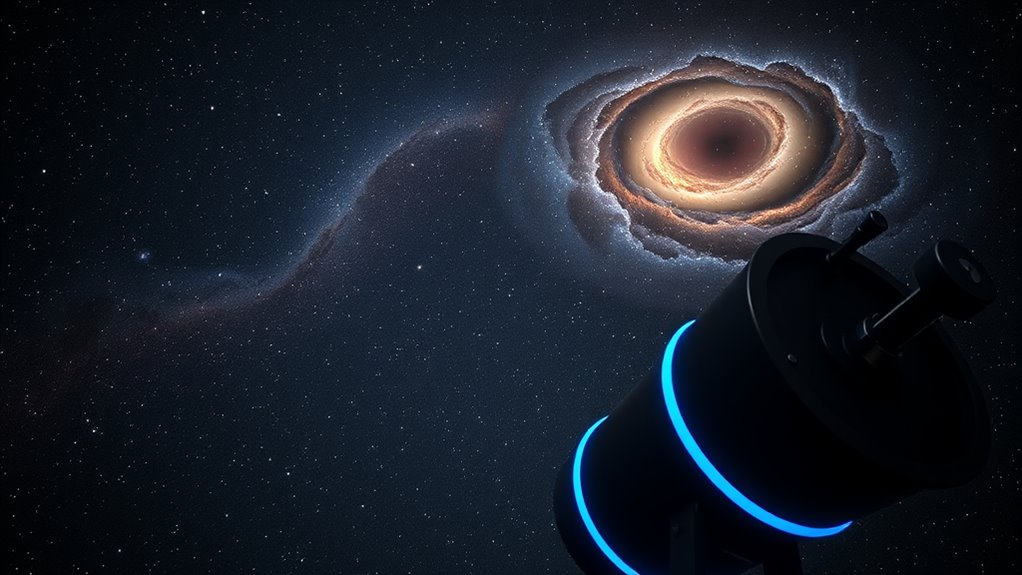Scientists have detected gravitational waves that originated from the earliest moments of the universe, shortly after the Big Bang. These signals provide direct evidence of cosmic inflation, a rapid expansion period that shaped the universe’s structure. This discovery confirms key inflationary theories and unravels new ways to explore the universe’s infancy. If you want to understand how these waves reveal the universe’s origins, there’s much more to explore beyond this exciting breakthrough.
Key Takeaways
- Gravitational waves from the universe’s inflationary period have been directly detected, confirming predictions of early universe expansion.
- These waves provide new insights into conditions moments after the Big Bang, complementing cosmic microwave background data.
- Detection supports inflation models involving rapid, intense expansion, helping refine theories of the universe’s origins.
- Gravitational waves encode information about violent early universe events, revealing extreme conditions during cosmic infancy.
- This discovery advances gravitational wave astronomy and opens new avenues for exploring the universe’s earliest moments.

Scientists have announced the first direct detection of gravitational waves originating from the universe’s earliest moments, providing new insights into the inflationary period just fractions of a second after the Big Bang. This groundbreaking discovery opens a window into the universe’s infancy, allowing you to glimpse phenomena that shaped everything we observe today. The detection focuses on the subtle ripples in spacetime created during the universe’s rapid expansion, known as inflation. These waves carry a wealth of information about the conditions that existed when the cosmos was unimaginably young.
You might wonder how these signals relate to the cosmic background, the faint afterglow of the Big Bang that permeates the universe. The cosmic microwave background (CMB) already offers clues about the universe’s early state, but gravitational waves add a new dimension to this understanding. While the CMB reveals temperature fluctuations and polarization patterns, the gravitational waves encode information about the universe’s most violent moments, including the inflationary burst. Detecting these waves confirms that inflationary models—scientific theories describing the universe’s rapid early expansion—are on the right track. They suggest that the universe expanded exponentially in a fraction of a second, smoothing out irregularities and setting the stage for galaxy formation.
Gravitational waves reveal early universe moments beyond the cosmic microwave background’s reach.
By observing these primordial gravitational waves, you now have concrete evidence supporting the idea that inflation happened. This evidence helps distinguish between different inflationary models, some predicting stronger or weaker gravitational wave signals. The data point toward models where the universe underwent a swift, intense burst of expansion, leaving behind a unique gravitational wave imprint. As a result, scientists can refine their theories, narrowing down the characteristics of inflation and better understanding the physics at play during those earliest moments.
This discovery also enhances your comprehension of the universe’s fundamental nature. It confirms that spacetime itself was subject to extreme conditions, and that these conditions left observable traces. The detection underscores the importance of gravitational wave astronomy as a tool for probing the universe’s most elusive epochs, far beyond what electromagnetic observations alone can reveal. Through this breakthrough, you’re witnessing a pivotal step in cosmology: directly linking the universe’s initial moments to modern observations. It’s a remarkable achievement that not only supports existing inflationary models but also paves the way for future research to explore the mysterious origins of everything you see around you.
Frequently Asked Questions
How Do Gravitational Waves Differ From Other Cosmic Signals?
You notice that gravitational waves differ from other cosmic signals because they are ripples in spacetime caused by quantum fluctuations during the universe’s inflation. Unlike electromagnetic signals, which come from stars or galaxies, gravitational waves pass through matter without scattering, carrying unique information about the early universe. They contribute to the cosmic background, providing insights that other signals can’t, making them essential to understanding cosmic origins.
What Are the Implications of This Discovery for Cosmology?
This discovery opens a new chapter in cosmology, like unsealing a cosmic time capsule. You get to see how the universe’s earliest moments shaped everything we observe today. It bolsters inflationary theories, confirming that rapid expansion occurred right after the Big Bang. These insights refine cosmological models, helping you understand the universe’s birth and evolution with greater clarity. This discovery acts as a guiding star in your quest to decode cosmic origins.
Could This Detection Influence Future Space Exploration Missions?
Yes, this detection could substantially influence future space exploration missions. You might see advancements in spacecraft instrumentation designed to detect gravitational waves more precisely, which can open new avenues for understanding the universe’s origins. It could also impact mission planning by prioritizing projects that focus on studying cosmic phenomena through gravitational wave signals, enabling you to explore earlier cosmic events and expand our knowledge of the universe’s infancy.
How Precise Are Current Instruments in Measuring Early Universe Signals?
Your instruments are highly sensitive, allowing for precise measurements of early universe signals. Their sensitivity directly impacts measurement accuracy, helping you detect faint gravitational waves from the universe’s infancy. While current technology offers impressive precision, ongoing improvements aim to refine this accuracy further. These advancements enable you to better understand cosmic origins, making your observations more reliable and opening new frontiers in astrophysics research.
What Challenges Remain in Confirming the Inflationary Origin of These Waves?
You face challenges in confirming the inflationary origin of these waves because of limitations in instrument sensitivity and data validation. Current instruments may not be sensitive enough to distinguish signals from background noise, making it hard to confirm their origin. Additionally, rigorous data validation is vital to rule out false positives and guarantee the detected waves genuinely stem from early universe inflation, necessitating further technological improvements and cross-checks.
Conclusion
You now stand at the threshold of understanding the universe’s earliest whispers, much like hearing the faint echoes of creation itself. Just as Prometheus brought fire to illuminate mankind’s path, these gravitational waves reveal secrets of cosmic origins long hidden in the shadows of time. With this discovery, you’re invited to glimpse the universe’s infancy, opening new chapters in the epic story of existence—reminding us that even the smallest ripples can reveal the greatest truths.









